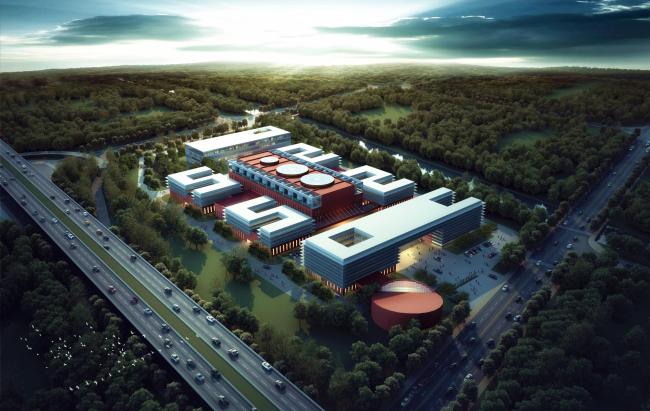Hypergravity—A novel approach to time and space
Any object on the earth is subject to gravity as a result of the gravitational attraction and the centrifugal force caused by the earth’s rotation. Scientists perceive the gravitational field as the normal gravitational field (1g≈9.8 m/s2) and define the condition where the force of gravity exceeds that on the surface of the earth (greater than 1 g) as hypergravity.
Apparently, in the context of hypergravity, there will emerge some magical effects indiscernible in daily life. First, hypergravity elevates the volumetric force of matter and produces a scale effect. For example, if we want to know the impact of a 100-story building on the foundation, we only need to build a one-story model, and under the influence of 100 g hypergravity, we can simulate the effect of a 100-story building. Second, the hypergravity field accelerates the driving force of the relative motion between different substances, resulting in a time-reducing effect. In the explosion experiment under the hypergravity field, hypergravity can increase the velocity of the bubble and speed up phase separation.
The hypergravity field is used to simulate the motion process of normal gravity multiphase media. It is featured by three basic scientific effects: time-space compression, energy enhancement and accelerated phase separation. It can promote the human ability to observe the motion process of multi-phase media with strong forces of gravity and space-time scales, and provide extreme physical conditions foraccelerated separation of multiphase media. It is dueto its immense power that the hypergravitycentrifugal is hailed as a “revolutionary tool” for creating a hypergravity environment on the planet. At present, the maximum capacity of centrifuges in the world is 1200 g•t (gravity acceleration × ton).

The Centrifugal Hypergravity and Interdisciplinary Experiment Facility (CHIEF), headed by Zhejiang University, is a large-scale complex scientific experimental facility which integrates a hypergravity centrifuge with other high-pressure and high-temperature airborne devices to superimpose the hypergravity field onto the extreme environment. CHIEF is heralded as a leading pioneer, inspiring global scientists to delve deeper into construction of major infrastructure, exploitation of deep-sea and deep-land resources and development of high-performance materials. This facility consists of main units, experimental cabins, a test supporting system and other auxiliary devices. Among them, two main units have the maximum capacity of 1900 g•t, the maximum centrifugal acceleration of 1500 g and the maximum load of 32 t. In addition, there are six hypergravity experimental cabins, including slopes and high dams, geotechnical engineering, deep-sea engineering, deep-land engineering and environment, geological processes and material preparation. The facility is expected to be completed in five years. Upon completion, it will fill the void in China’s ultra-large hypergravity facilities and become the world’s leading and most extensive multi-disciplinary experimental platform.
“CHIEF can provide an innovative approach to studying the spatial and temporal evolution of geomaterials and deep matter in the depths of the Earth and accelerating the phase separation of matter and offer a state-of-the-art platform for the undertaking of major scientific and technological tasks, the development and verification of new technologies as well as the evolution of cutting-edge matter science, thereby remarkably boosting the research level and international competitiveness of relevant multidisciplinary fields in China,”says CHEN Yumin, a professor from the College of Civil Engineering and Architecture who is in charge of this project.
In general, CHIEF will elevate the capacity of the hypergravity centrifuge from 400 g•t and to 1900 g•t. It will thus be armed with the capacity to reproduce the evolution of rock and soil and the diachronic transfer of pollutants over millennia and procure thousands of components in one single experiment.
In response to the construction and operation of CHIEF, Prof. CHEN Yunmin looks forward to the participation of the world’s elite researchers. “This facility will be open to users in multiple fields and render scientific research and exchanges at home and abroad,” says CHEN Yunmin,“National scientific and technological infrastructure should lend generous support to scientific and technological development in the domain of hypergravity in China and even the whole world.”
The first step in attaining a scientific goal is to create a hypergravity field on the earth. This is also CHIEF’s first mission in building a hypergravity centrifugal simulator. The hypergravity centrifuge generates centrifugal acceleration in the experimental cabin by means of the high-speed rotation of rotating arms, and matter in the cabin is thus affected by the centrifugal force. “Of course, it will still be influenced by the acceleration of gravity, but 1 g is infinite small in comparison with centrifugal acceleration and can therefore be ignored,”CHEN Yunmin explains.
With the hypergravity field, scientists can perform various experiments in CHIEF’s six hypergravity experimental cabins and 18 airborne devices. They can observe the matter movement of multi-phase media such as rock and soil, deep geo-matter and alloy melts in the hypergravity environment. They can also reveal the large-scale spatial and temporal evolution of rock and soil, geological processes, diagenesis and mineralization as well as the hypergravity solidification of alloy melts, thus facilitating construction of major infrastructure, exploitation of deep-sea and deep-land resources, and development of high-performance materials.